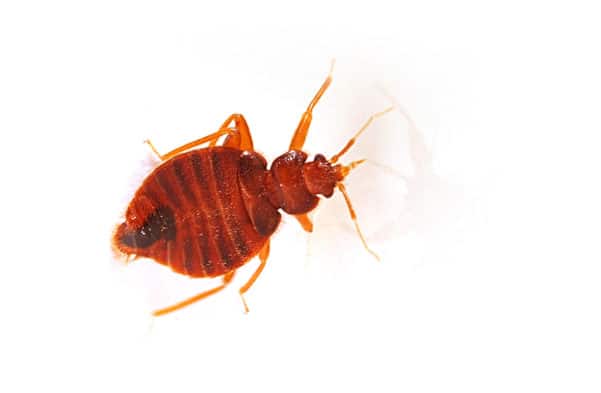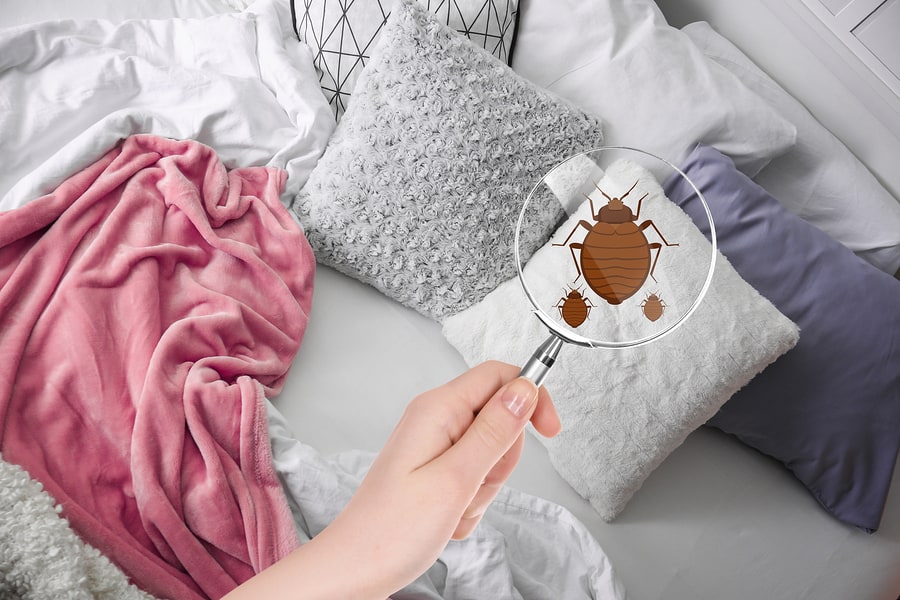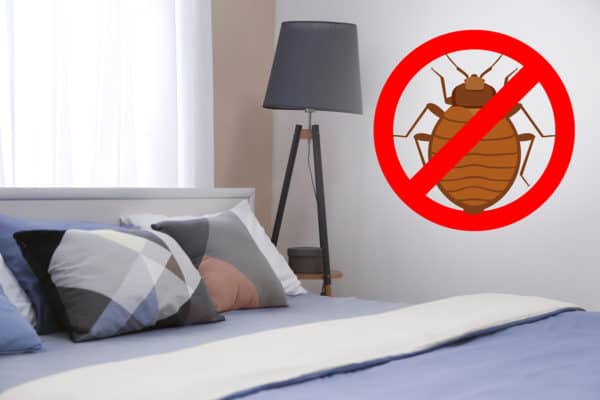READY TO GET STARTED?
REQUEST A FREE ESTIMATE
Fill out the form below or call (888) 466-7849 for a free, no-obligation estimate.

Bed bugs are an extremely difficult pest to get rid of. Is there a season that is worse for bed bugs than others? While there is no official bed bug season, a recent study published in the Journal of Medical Entomology shows a peak in bed bug activity in August and a low in February. Other studies have shown that peak season for bed bugs runs from June through October. Bed bugs appear more prevalent in warmer months likely due to an increase in travel and hotel visits during spring break and summer vacation, as well as college students moving into dorms at the beginning of the school year. More movement, more travel and more activity lead to an increased opportunity for bed bugs to hitch a ride on luggage, people and pets. This increase in travel also allows them the opportunity to spread very quickly, establishing new infestations practically overnight.
Bed bugs have been found in homes, college dorms, nursing homes, schools, hospitals, office buildings, hotels, daycares, hospitals, public transportation, and even planes.
Even though bed bug season appears to peak in the warmer months, they still remain active year round. That’s why it is important to be vigilant when traveling or hosting out of town visitors regardless of the time of year. Here are some tips to help prevent bed bugs from infesting your home.
If you suspect you have a bed bug infestation, contact a professional bed bug control company who can provide you with a thorough inspection and set you up with a comprehensive treatment and prevention plan going forward.
Stop Leaves at the Line of Scrimmage with Gutter Protection!
Are Termites Active In Fall and Winter?

Bed bugs are one of the most difficult pests to get rid of. Early detection is critical for bed bug control. A minor infestation can be an inconvenience but it is much less expensive and easier to treat than a widespread infestation. Minor infestations can be difficult to find and correctly diagnose, however. Other insects like carpet beetles are often mistaken for bed bugs. Misidentification or delay in detection can allow the bed bugs more time to spread and proliferate. How do you find bed bugs? Where can bed bugs hide?
The first step in finding bed bugs is properly identifying them. Adult bed bugs are brown or reddish-brown with flat, oval-shaped bodies that are about 1/4″ to 5/8″ long. Their flat body shape allows them to hide in cracks and crevices. Bed bugs become swollen and engorged after feeding. They are found throughout the United States.
Learning and understanding the habits and behavior of bed bugs can also help identify an infestation early. Bed bugs like to travel and are notoriously good hitchhikers. Bed bugs usually emerge at night in search of their blood meal but will feed during the day if necessary. While bed bugs are most commonly known for feeding on humans, they will also feed on other mammals and birds too. They usually hide near their food source.
Knowing and recognizing the signs of a bed bug infestation is key to identifying them early and getting rid of them quickly. Some common signs of bed bugs include:
Once you know the signs to look for, the next step is to thoroughly inspect any areas that could potentially harbor bed bugs. Bed bugs are found in every place humans gather including homes, hotels, schools, offices, stores, and public transportation. They like to use their flat shape to hide in cracks and crevices close to humans. They can fit in any opening the width of a credit card. When checking for bed bugs, use a flashlight and magnifying glass to thoroughly check the following areas:
Bed bugs can be extremely difficult to get rid of. If you spot signs of a bed bug infestation, contact a licensed pest control company who can positively identify the bed bugs and use professional grade techniques and products to eliminate the infestation. In the meantime, there are some things you can do to help prevent bed bugs in the first place.
How Dangerous Are Cockroaches?
How Long Does A Mosquito Treatment Last?
5 Ways to Get Rid of Millipedes

Just as the weather changes with the seasons, pest activity shifts to usher in new groups of active pests. Let’s take a look at what pests are active in your area and some tips to keep them away.
The humidity and moisture that come with early summer is what helps to increase subterranean termite activity. “Swarm season” is in full effect, and this can present a problem for your home.
Summer is the biggest travel time for many. College students are coming back home, and family vacations are planned. This increases the chances of having an incident with bed bugs, and a bed bug infestation is no easy battle.
As the summer weather starts to rev up, American cockroach activity will skyrocket. While they live outdoors, if they find themselves low on food or if the weather experiences a drastic change (extreme heat or excessive rain), they will try move indoors.
Pest infestation can be costly and a major hassle. Contact a professional pest control company like Northwest for a free pest control estimate to protect your home from pests year-round.

Now that the holidays and spring break are over, travel season is slowing down; but that doesn’t mean that bed bug season is too. Bed bugs are active year-round. Even though you may not be travelling, guests coming to your home can bring bed bugs in too. Bed bugs are nuisance pests that are extremely difficult to get rid of. They are notorious hitchhikers, most commonly catching a ride on bags, purses, luggage, and wheelchairs, but they can also be found on clothing. Anyone can bring bed bugs into your home – an unexpected house guest, your spouse returning from an out of town work trip, or even your child coming home for a visit from college. Once bed bugs have gotten into your home, professional bed bug control is your best option to get rid of them. However, there are things you can do to help keep guests from bringing these pests into your home.
What You Should Know Before Termite Swarming Season
What Attracts Cockroaches To A Clean House?
10 Ways To Care For Your Lawn In Extreme Heat

With the increase in travel during the upcoming Spring Break season, the incidence of bed bugs will be on the rise. Bed bugs are difficult to get rid of; notorious hitchhikers that can travel with ease from place to place. They also don’t discriminate – bed bugs have been reported in accommodations ranging from 1 star motels to 5 star luxury resorts and everywhere in between, and have been reported around the world. Most home bed bug infestations occur after travel or are brought in by guests. So what can you do to make sure these pests don’t arrive uninvited after your spring break travels?
There are several resources out there that provide reports of bed bug infestations at hotels and other lodging facilities. The Bed Bug Registry is a free public database of user-submitted bed bug reports from across the United States, Canada, and the United Kingdom. Established in 2006, the Bed Bug Registry has mapped more than 12,000 hotels based on over 20,000 reports from travelers. Other user-generated sites like TripAdvisor also offer reviews that include bed bug reports.
Bed bugs are small, only about 4 to 5 mm in size. They are the size of a standard pearl. They have flat, oval-shaped bodies that are red or brown in color. Before traveling, download the EPA’s wallet-sized bed bug identification card for reference.
Where do you look for bed bugs? Bed bugs are excellent hiders. They are nocturnal so finding them during the day can be a challenge. Always check your room thoroughly before unloading your luggage. Bed bugs are usually found within 20 feet of a host (usually a bed). Bed bugs are commonly found in the seams of mattresses, in the cracks of headboards, in baseboards, and in the folds of upholstered furniture. They can also be found in drawers and closets and even in the fabric of luggage rack straps. Be sure to check each of these places thoroughly and use a flashlight if possible. Leave your luggage outside the door while you check for bed bugs. Be sure to also check the sheets and mattress for small brown spots sometimes tinged with blood. This is a tell-tale sign of a bed bug problem.
If you find evidence of bed bugs in your room, notify the front desk and hotel manager immediately. Request to be transferred to another room that is not above, below, or adjacent to the infested room as bed bugs can travel through cracks in the ceiling, walls, and floor. If you aren’t comfortable, request a refund and find other accommodations. Request that the hotel launder your clothes immediately. Place all your garments in a sealed bag and put them in the dryer again when you get home. Steam your luggage, as well.
One way to avoid bed bugs is to take steps to prevent them in the first place. Pack a large trash bag with your luggage and store your luggage in it while in the room. Don’t leave any clothes, purses, or computer bags on upholstered furniture in your room. Keep all bags closed when not in use. Double check your bags and clothing before you repack. Once you return home, immediately unpack your dirty clothes directly into the washer and then dry them on high heat. Store your suitcases away from any living areas such as in the garage or the basement.
Bed bugs can be extremely difficult to get rid of. If you suspect you have a bed bug problem, contact a professional pest control company who can provide you with a thorough inspection and the appropriate treatment plan for your situation.
What Attracts Cockroaches To A Clean House?
Is Your Hotel On The Bed Bug Registry?
A Step-By-Step Guide To Spring Lawn Care
So You Think You Have Bed Bugs: Now What?
What Are Your Termite Treatment Options?